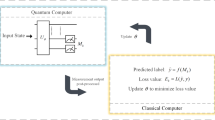Abstract
With the development of quantum computation theory, some researchers further apply it to improve the efficiency of classical machine learning algorithms. Based on physical graph state, an efficient quantum version of classifier is proposed in this paper. Different from existing classical methods, realizing the proposed scheme is an entangling-subgraphs process of physical system to build the classifier by using the graph states. Resort to the efficiency of graph state, the quantum algorithm is more efficient to big data than the classical ones.

Similar content being viewed by others
References
Nielsen, M.A., Chuang, IS: Quantum Computation and Quantum Information. Cambridge University Press, Cambridge (2000)
Cirac, J.I., Zoller, P.: A scalable quantum computer with ions in an array of microtraps. Nature 404, 579–581 (2000)
Sasaki, M., Carlini, A.: Quantum learning and universal quantum matching. Phys. Rev. A 66, 022303 (2002)
Hentschel, A., Sanders, B.C.: Machine learning for precise quantum measurement. Phys. Rev. Lett. 104, 063603 (2010)
Pudenz, K. L., Lidar, D. A.: Quantum adiabatic machine learning Quantum. Quant. Inf. Proc. 12, 2027 (2013)
Rebentrost, P., Mohseni, M. , Lloyd, S.: Quantum support vector machine for big data classification. Phys. Rev. Lett. 113, 130503 (2014)
Schutzhold, R.: Pattern recognition on a quantum computer. Phys. Rev. A 67, 062311 (2003)
Aïmeur, E., Brassard, G., Gambs, S.: Machine learning in a quantum world. In Advances in Artificial Intelligence, pp. 431–442. Springer (2006)
Wittek, P.: Quantum Machine Learning; What Quantum Computing Means to Data Mining. Academic Press, Boston (2014)
Schuld, M., Sinayskiy, I., Petruccione, F.: An introduction to quantum machine learning. Contemp. Phys. 56, 172–185 (2015)
Biamonte, J., et al.: Quantum machine learning. Nature 549, 195. EP (2017)
Schuld, M., Petruccione, F.: Supervised learning with quantum computers. Springer, Cham (2018)
Türkpençe, D., Akncı, T.Ç., Serhat, Ş.: A steady state quantum classifier. Phys. Lett. A 383(13), 1410–1418 (2019)
Schuld, M., Killoran, N.: Quantum machine learning in feature Hilbert spaces. Phys. Rev. Lett. 122, 040504 (2019)
Blank, C., Park, D. K., Rhee, J. K. K., et al.: Quantum classifier with tailored quantum kernel. npj Quantum. Inf. 6, 41 (2020)
Dür, W., Aschauer, H., Briegel, H. J.: Multiparticle entanglement purification for graph states. Phys. Rev. Lett. 91, 107903 (2003)
Raussendorf, R., Browne, D. E., Briegel, H. J.: Measurement-based quantum computation using cluster states. Phys. Rev. A 68, 022312 (2003)
Briegel, H. J., Raussendorf, R.: A One-Way quantum computer. Phys. Rev. Lett. 86, 910 (2001)
Hein, M., Eisert, J., Briegel, H. J.: . Phys. Rev. A 69, 062311 (2004)
Aschauer, H., Dür, W., Briegel, H. J.: . Phys. Rev. A 71, 012319 (2005)
Hu, D., et al.: . Phys. Rev. A. 78, 012306 (2008)
Manh Nguyen, D., Kim, S.: Int. J. Mod. Phys. B 33(24), 1950274 (2019)
Acknowledgments
This work is supported by Natural Science Foundation of China (No.62072207), Natural Science Foundation of Shanghai (No.19ZR1420000), Henan Key Laboratory of Network Cryptography Technology (No.LNCT2020-A05), Open Foundation of Network and Data Security Key Laboratory of Sichuan Province (University of Electronic Science and Technology of China) (No. NDS2021-1) and Program for Innovative Research Team of Huizhou University.
Author information
Authors and Affiliations
Corresponding author
Additional information
Publisher’s Note
Springer Nature remains neutral with regard to jurisdictional claims in published maps and institutional affiliations.
This work is supported by Natural Science Foundation of China (No.62072207), Natural Science Foundation of Shanghai (No.19ZR1420000), Henan Key Laboratory of Network Cryptography Technology (No.LNCT2020-A05), Open Foundation of Network and Data Security Key Laboratory of Sichuan Province (University of Electronic Science and Technology of China) (No. NDS2021-1) and Program for Innovative Research Team of Huizhou University.
Rights and permissions
About this article
Cite this article
Li, Y., Meng, Y. & Luo, Y. Quantum Classifier with Entangled Subgraph States. Int J Theor Phys 60, 3529–3538 (2021). https://doi.org/10.1007/s10773-021-04922-w
Received:
Accepted:
Published:
Issue Date:
DOI: https://doi.org/10.1007/s10773-021-04922-w




